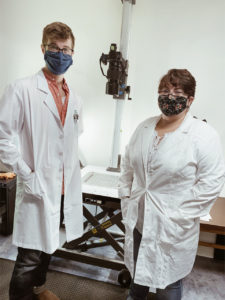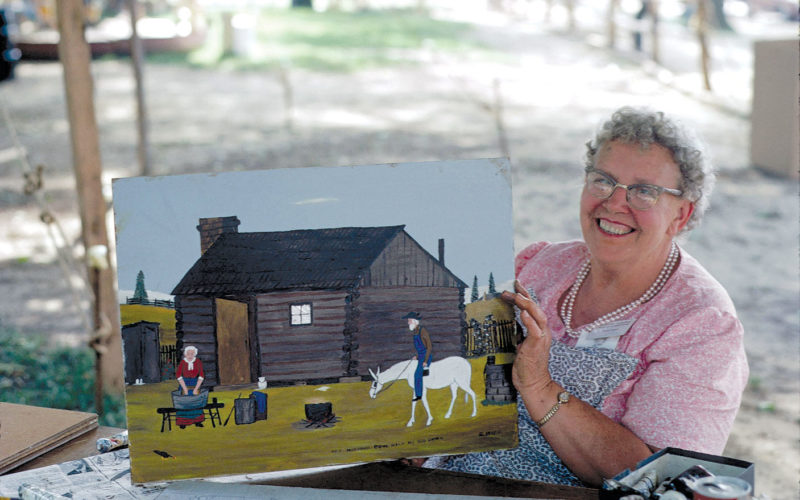Shiloh Museum sets goals for growth in 2021
BECCA MARTIN-BROWN
bmartin@nwadg.com
Never ask Allyn Lord her objectives for the Shiloh Museum of Ozark History — at least, not unless you have time to hear the answer(s). Asked her biggest goal for 2021, her first response is, “Will you permit me more than one?”
Then Lord, the museum’s director since 2005, makes her list:
Fully ramp up our digitization program.
“Shiloh Museum of Ozark History has the largest collection of historic image in Arkansas, at nearly 1 million,” Lord says. “From the collection’s earliest days, we recognized the significance of these resources for the public. But in this day and age, access to digital images is vital, so we began a digitization program which includes creating and maintaining high-quality images online, with their accompanying information, for use by researchers, students, authors and others. The program will provide a compelling user experience, facilitate open access to digital collections, and reflect the breadth and depth of information and collections held by the museum about the Arkansas Ozarks.”
For the Shiloh Meeting Hall, complete the roof replacement, window repairs and repainting.

Photographer/digitization project manager Bo Williams and research specialist Rachel Whitaker pause next to the copy stand where historic images will be photographed. Making the Shiloh Museum’s collection of nearly 1 million historic images available online is one of the goals of the museum’s director, Allyn Lord.
(Courtesy Photo/Shiloh Museum)
“While we celebrated the renovation and opening in 2018 of the historic 1871 Shiloh Meeting Hall, the longer-term goal was to adapt the second floor of that building into an exhibit hall, displaying the history of the many organizations that called the building home over the years,” Lord explains. “This year the roof will be replaced, the windows will be repaired, and the exterior painted, and we’ll be installing those exhibits soon thereafter. We’ll do all that in 2021 because, by year’s end, we’ll celebrate the sesquicentennial (150th birthday) of the hall.”
Work with the newly created position of museum development manager to strategize a three- to five-year plan.
“The goals and vision themselves haven’t changed, but our progress in working towards them certainly has,” she says. “The audacious vision of a museum campus covering a full city block — meaning that four adjacent properties needed to be acquired — took a giant leap in 2020 with the purchase by the city of a next-door duplex (which is now our digitization center, exhibits shop, and offices) and with the donation by the Tyson Family Foundation of the second next-door duplex (which is temporarily a storage facility). We will soon engage a master planner to work with us and involve the community in visioning how the property will eventually be used. Additionally, as downtown Springdale evolves into a dynamic destination, the museum continues to partner with local organizations to be a part of that growth.”
Use lessons we learned from our covid closure and reopening to create a better, more inclusive, more responsive museum.
“While the museum was fairly active online before covid, we’ve learned – as have museums nationwide – that presenting virtual programs, events, and even exhibits makes them more accessible and opens up a broader audience to, in our case, Arkansas Ozark history,” Lord says. “Post-covid, we’ll definitely look forward to seeing people come back to the museum for onsite programs, events and exhibits, but many more people will be able to find and use our services online, so those will no doubt continue to grow. We’ve also learned that visitors miss those things they can’t access now due to covid, such as the hands-on activities that normally inhabit our exhibit hall and visits inside our historic buildings. Those things were permanent before and will be post-covid, but it’s validating to know they play a big part in the visitor experience here.”
Reflecting on the year just past, Lord says “there wasn’t much in 2020 that didn’t get accomplished, albeit often in a different format. Exhibits still opened but also went online. Almost all scheduled programs took place, but virtually rather than onsite. Big activities — including the annual Ozark Quilt Fair, our summer history camps, the annual Arkansas Symbols Day, the new and now-to-be-annual Native American Days — all happened virtually and attracted huge audiences.
“Our only real disappointments were in not being able to host visitors, speakers, our 11 history-related groups and school classes. [But] those big activities I just spoke of were way better than we had hoped for. For our two week-long history camps, we can accommodate up to about 40 campers. Online we were able to host 110, including two campers on the autism spectrum who couldn’t have participated onsite. Our first stab at Native American Days, for which we expected perhaps 500 onsite students, attracted 2,110 virtual participants, including some from outside the Northwest Arkansas area. Additionally, the resources created for that event are now an online and accessible and have received excellent reviews by teachers and historians.
“I don’t believe there’s a person alive who can predict today when it will be safe enough to resume in-person activities at the museum,” she concludes. “But we know that day will come, and we’ll flip the switch to make it happen, just as we did last March when it was going the other way. We’ll be ready for that return, but the experience in presenting all-virtual activities and the lessons learned during covid mean that many more activities that were once only in-person will also be more accessible online.”

The paintings created by folk artist Essie Ward of Marshall grew in popularity when she was invited to participate in the Smithsonian’s Festival of American Folklife in Washington, D.C., in 1970. The Shiloh Museum of Ozark History has 59 Essie Ward paintings, believed to be the largest and most complete collection of her work. Ward, who died in 1981, will be remembered in a new exhibit, “I Just Know I Like to Paint,” opening Feb. 8.
(Courtesy Photo/Shiloh Museum)
FYI
Shiloh Museum
Upcoming Events
Exhibits:
Opening Feb. 8 – “I Just Know I Like to Paint,” an exhibit about Ozark folk artist Essie Ward.
Opening April 28 – “Meet the Searcys,” a look at the Northwest Arkansas family who’s eponymous home is on the Shiloh Museum grounds.
Opening June 15 – “Gone Fishing,” a photo exhibit about the sport in Northwest Arkansas.
Online programs:
Feb. 17, noon – “Nelson Hackett’s Escape from Fayetteville and Slavery,” a Zoom program with Dr. Michael Pierce from the University of Arkansas, about the slave who fled Arkansas in 1841, his flight to Canada, abolitionist efforts to prevent his extradition back to Arkansas, and the diplomatic crisis that his return provoked; one of the virtual Shiloh Sandwiched-In series.
March 17, noon — “Northwest Arkansas Fashion Week,” a Zoom program by Robin Atkinson, CEO of the NWA Fashion Forum, about the history, focus, purpose, and stories of the annual event; one of the virtual Shiloh Sandwiched-In series.
Right now, the museum is open 10 a.m.-5 p.m. Monday through Friday and is closed on Saturday.
INFO — 750-8165 or shilohmuseum.org



